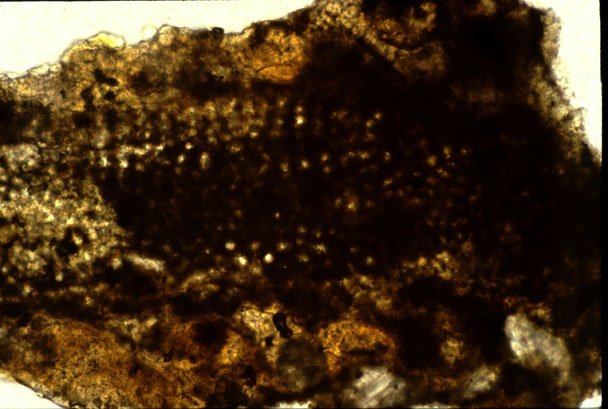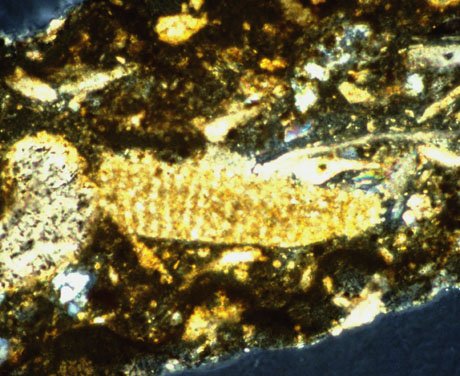
These thin sections were made by Dr. Ivan Sansom of the Univ of Birmingham, UK.
"The core of them seems to be formed
from stereom, so I'd suggest that they are secondarily
phosphatised echinoderm
plates...... There has been a lot of alteration, the fine grained
brown "crud" is common in my experience where
specimens have undergone secondary phosphatization, and there are
some well developed crystals of apatite in 3(second image)."
Ivan Sansom, 12/09/1999
Many thanks to Ivan for making these thin sections and graciously imaging them and making them available for our analysis.
Image 1

Image 3

Subsequent thin sections were done by Dawn Peterson of the California Academy of Sciences in San Francisco in June 2000. She had these comments.
"After thin-sectioning the so-called mystery fossil I observed a tan outer-shell layer and an interior region comprised of what appeared to be very thin, reddish colored tubular structures running perpendicularly to the exterior comb-like ridges. I was not successful in observing the terminal portions of any of the internal tubes, but was able to ascertain that they were, indeed tubular. The rest of the internal region appeared to be filled with an amorphous substance, probably sediment(?).
I also have in my possession, thanks to Bill, a few specimens in which multiple individual elements are in close proximity. I suspect this is not coincidental, but that these individual components may have formed longer structures in life. Might they not represent some form of gill, respiratory support, or filter-feeding structure from some sort of invertebrate? They are calcified, although I have no idea what sort of organism might have developed such structures.
Also, the hinge structure of the bivalve Lyrodesma only
generally resembles that of our beast. In my specimens of
Lyrodesma, the teeth are much less regular and fewer in number
than the aforementioned pelecypod. Further, these objects are
clearly not vertebrate in origin."
Dawn Peterson, 06-22-2000
Thank you so very much, Dawn, for doing these thin sections and for taking the extra time to examine, more closely, the "mystery fossil".
I have some additional thoughts regarding these findings and
will publish more images and analysis shortly. So stay tuned!
Bill Heimbrock, 08-21-2000
Interpretation After Correct Identification
The stereom and other debris in the center of the "Mystery Fossil" is the
debris that was originally stuck between the dentitions of the bivalve hinge.
This debris has the same composition as the "Cyclora Hash" that surrounds the
bivalve hinge.
- - Bill Heimbrock, 2016